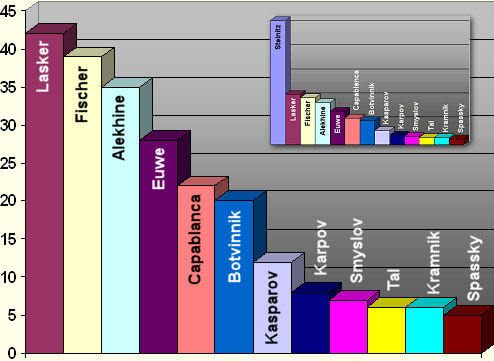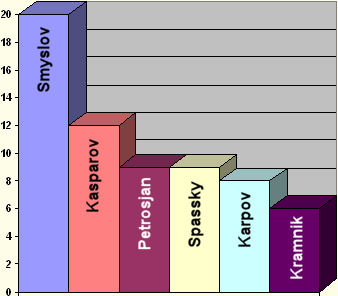World Champions and Draws
A statistical investigation by Johannes Fischer
Should there be a vote for the most brilliant and exciting games of 2004,
the 14th game from the world championship match between Kramnik and Leko would
certainly be a candidate for a top place. It not only decided the world championship,
but also showed how brilliantly Kramnik can perform under pressure. In this
game, which Kramnik had to win to defend his title, he exchanged queens early
on to exert pressure with his remaining pieces, which led to a mating attack
in the endgame. But despite this sparkling finish many chess fans were disappointed
by the match. They particularly criticized the high number of short draws,
and indeed, six of the fourteen games were drawn after 23 moves or less.
In interviews which Kramnik gave after the match he asked the public to take
a more positive view, to accept his role as an expert who knows what he is
doing, and likened himself to an artist who cannot deliver masterpieces on
demand (see e.g. Kramnik's interview with Dirk Poldauf in Schach 12/04, p.49-54
or Kramnik's interview with Dirk Jan ten Geuzendam in New in Chess 8/2004,
p.68-74).
Kramnik interviews are always a pleasure to read. They are clear, thought provoking
and impress through objectivity. However, in this case his arguments fail to
convince. No one expects Kramnik to produce one brilliancy after another. All
the public wants is a bit more fighting spirit. After all, attractive tournaments
with high prizes and high starting fees will only be organized if enough people
show an interest in chess – and nobody wants to see bloodless draws.
Kramnik also pointed out that other world champions such as Petrosian and
Spassky were not adverse to an occasional short draw either. The following
table tries to clarify how the fourteen world champions handled the question
of draw or not to draw. The table is based on the BigReference database in
ChessBase 9, from which the simultaneous, blitz and rapid games were filtered,
so that the data only includes tournament and match games. Moreover, only games
until the end of 2003 were included.
| Name |
gms
|
wins
|
draws
|
losses
|
ø len.
|
ø draws
|
<20 |
quo
|
| Steinitz |
618 |
342=55%
|
125=21%
|
151=24%
|
39 |
42 |
6 |
103 |
| Lasker |
549 |
303=55%
|
173=32%
|
73=13%
|
42 |
41 |
13 |
42 |
| Capablanca |
642 |
337=52%
|
261=42%
|
44=6%
|
39 |
35 |
29 |
22 |
| Alekhine |
1240 |
719=58%
|
390=32%
|
130=10%
|
41 |
41 |
35 |
35 |
| Euwe |
1384 |
657=47%
|
502=37%
|
221=16%
|
37 |
35 |
49 |
28 |
| Botvinnik |
977 |
461=47%
|
400=42%
|
116=11%
|
41 |
39 |
49 |
20 |
| Smyslov |
2699 |
923=34%
|
1450=55%
|
295=11%
|
37 |
33 |
393 |
7 |
| Tal |
2456 |
982=40%
|
1202=49%
|
270=11%
|
35 |
30 |
396 |
6 |
| Petrosian |
2087 |
766=36%
|
1155=57%
|
165=7%
|
35 |
29 |
389 |
5 |
| Spassky |
2291 |
749=32%
|
1329=59%
|
212=9%
|
34 |
29 |
450 |
5 |
| Fischer |
733 |
407=55%
|
241=34%
|
85=11%
|
41 |
42 |
19 |
39 |
| Karpov |
2164 |
822=37%
|
1167=55%
|
175=8%
|
40 |
36 |
265 |
8 |
| Kasparov |
1265 |
540=42%
|
627=51%
|
98=7%
|
37 |
34 |
103 |
12 |
| Kramnik |
867 |
314=36%
|
484=57%
|
69=7%
|
36 |
31 |
139 |
6 |
In the table "gms" is the total number of games; "ø
len." is the average length of these games; "ø draws"
is the average length of the drawn games; "<20" is the number
of games drawn in less than 20 moves; and "quo" is the total number
of games divided by the short draws (so a larger number is better).

A graphic rendition of the different world champions' fighting quota.
Steinitz is left out in the main graph because his quota distorts the rest.
The full graph is given as an inset.
Apart from the rather surprising peacefulness of the Soviet players after
Botvinnik, it is striking that the classical masters seem to have been more
belligerent, foremost Steinitz, who has the lowest drawing ratio of all world champions – though he also has the highest ratio of lost games.
The player with the highest ratio of won games is Alekhine (58%), followed
by Fischer and Lasker (both with a ratio of 55% won games). This is by no means
accidental as a glance at the length of the drawn games reveals. Here again
Fischer and Steinitz lead with an average of 42 moves, closely followed by
Lasker and Alekhine, whose drawn games last 41 moves on average. This group
of four also impresses by the low number of draws lasting 20 moves or less.
While Alekhine on average drew every 35th game in twenty or less moves, Fischer
did so only once in 39 games, and Lasker just once in 42 games. Steinitz played
almost no short draws at all, and the chance to encounter a short draw when
watching a Steinitz game was less than 1%.
Thus, Steinitz, Lasker, Alekhine and Fischer appear to be the world champions
with the greatest fighting spirit. They do have a higher ratio of won games
than their colleagues, their drawn games last longer and the number of their
short draws is lower.
At the other end of the scale we do find Smyslov, Petrosian, Spassky, Karpov
and Kramnik, who all draw more often than the other world champions. Here,
the dove of peace award goes to Spassky, who impresses us with a drawing ratio
of 59%, closely followed by Petrosian and Kramnik with 57% each. The average
length of their draws, which are markedly shorter than those of Steinitz, Lasker,
Alekhine and Fischer, as well as the frequency of short draws confirm the impression
of a certain peaceful pragmatism in the play of these world champions. The
draws of Petrosian and Spassky last only 29 moves on average, while Kramnik
draws after 31 moves. On average Petrosian and Spassky also agree in every
fifth game to a draw in twenty moves or less. Kramnik here shows a bit more
commitment and draws only every sixth game that quickly.
Seen from this angle Kramnik is right: Petrosian and Spassky played more and
quicker draws than he, without damaging their reputation. However, the number
of games given above refer to the entire career of the world champions. But
Kramnik, who was born on June 25th, 1975, is not even thirty. And if one takes
a look at how often the "peaceful" world champions drew until the
age of thirty, things look somewhat different. To satisfy the curiosity of
those wishing to know how much fighting spirit the young Kasparov showed, his
results are also included.
| Name |
period |
gms |
wins |
draws |
losses |
ø len |
ø draw |
<20 |
quo |
| Smyslov |
1921-1951 |
395 |
178=45% |
161=41% |
56=10% |
43 |
43 |
20 |
20 |
| Kasparov |
1963-1993 |
895 |
395=44% |
427=48% |
73=8% |
37 |
34 |
75 |
12 |
| Petrosian |
1929-1959 |
725 |
304=41% |
344=49% |
77=10% |
37 |
32 |
81 |
9 |
| Spassky |
1937-1967 |
777 |
322=41% |
386=51% |
69=8% |
37 |
33 |
89 |
9 |
| Karpov |
1951-1981 |
864 |
386=44% |
429=51% |
49=5% |
36 |
34 |
113 |
8 |
| Kramnik |
1975-2003 |
867 |
314=36% |
484=57% |
69=7% |
36 |
31 |
139 |
6 |
 This
table and the graph on the left shows that no other world champion in his younger
years drew so often and as quickly as Kramnik, who has the lowest ratio of
won games and the highest ratio of draws.Kramnik’s draws are shorter
than those of his rivals for the title of "most peaceful world champion",
and he is also the player with the highest number of short draws.
This
table and the graph on the left shows that no other world champion in his younger
years drew so often and as quickly as Kramnik, who has the lowest ratio of
won games and the highest ratio of draws.Kramnik’s draws are shorter
than those of his rivals for the title of "most peaceful world champion",
and he is also the player with the highest number of short draws.
However, let's look at the bright side. After all, Kramnik still has time
to infuse some bellicosity into these statistics. Maybe he only lacks the challenge
– a world championship match against Kasparov or Anand, could very well
remedy the situation.



















 This
table and the graph on the left shows that no other world champion in his younger
years drew so often and as quickly as Kramnik, who has the lowest ratio of
won games and the highest ratio of draws.Kramnik’s draws are shorter
than those of his rivals for the title of "most peaceful world champion",
and he is also the player with the highest number of short draws.
This
table and the graph on the left shows that no other world champion in his younger
years drew so often and as quickly as Kramnik, who has the lowest ratio of
won games and the highest ratio of draws.Kramnik’s draws are shorter
than those of his rivals for the title of "most peaceful world champion",
and he is also the player with the highest number of short draws.




